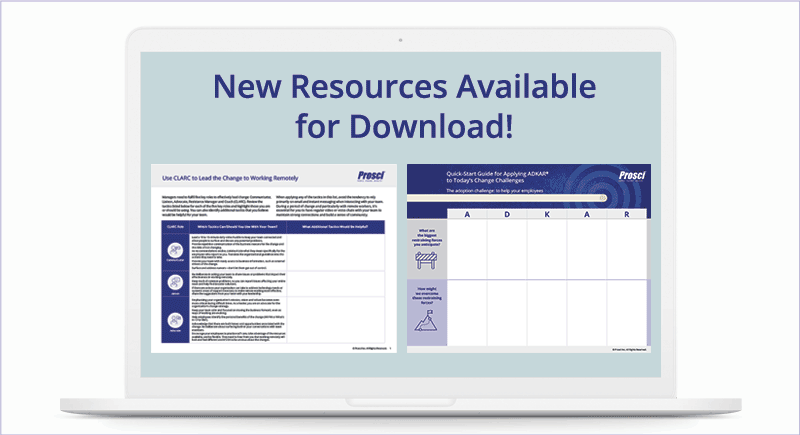

Change Management Blog
CLARC Role
October 23, 2023
Racha Kabbani: Brand Growth & Marketing Custodian
Time to Read: 4 Min
5 Critical CLARC roles

People managers play a pivotal role in the success of any change initiative. As the individuals closest to front-line employees who need to embrace new processes and behaviors, they can either serve as significant allies or formidable obstacles to change success.
Invariably, change also affects the way people managers carry out their own responsibilities. If a people manager is not aligned with a change, expecting them to rally their teams behind it becomes a challenging task. The responsibility falls on change leaders to influence the desire of people managers to support and guide their teams through the change. To achieve this, people managers must comprehend their 5 critical CLARC roles, how to execute them, and how each role aligns with the ADKAR® Model.
The Significance of People Managers
Engagement with people managers has consistently emerged as a key contributor to change management success in Prosci's Best Practices in Change Management benchmarking research since 2011. People managers hold a crucial position in change success due to their close relationships and proximity to employees directly impacted by change. Prosci's research highlights that a majority of employees prefer receiving personalized messages about changes directly from their managers, who are well-positioned to guide employees through their individual ADKAR® journeys.

The 5 CLARC Roles
While effective communication by people managers is essential, it alone is not adequate for ensuring successful change adoption. Prosci's research underscores that people managers have five distinct and crucial roles to fulfill during periods of change:
Communicator – Convey personal impact messages to direct reports regarding the change.
Liaison – Engage with and provide support to the project team.
Advocate – Demonstrate active support for the change.
Resistance Manager – Identify and address resistance to the change.
Coach – Assist employees in navigating the change process.
What are these exact CLARC roles?
Communicator: In the role of a communicator, people managers cultivate awareness of the need for change within their teams. Employees seek information about how a change will impact their work directly from their immediate supervisors. These managers serve as conduits for essential details, answering questions such as: What does this change mean for me? What are the benefits for me? Why should I embrace it? Why is this change happening? While the change management team provides talking points, it's the people manager's responsibility to deliver messages and address queries from team members.
Liaison: As liaisons, people managers influence reinforcement to sustain the change. They act as intermediaries between their employees and the project team, conveying information from the team to their direct reports. Importantly, they offer feedback from employees to the project team. Managers are well-placed to provide design input, usability feedback, and employee comments on specific aspects of the solution. They also play a crucial role in identifying functionality needs and concerns during the implementation phase.
Advocate: In the role of an advocate, people managers influence the desire to participate and support the change. Employees look to their immediate supervisors for direct communication about a change and to assess their level of support for the change effort. If a people manager only passively supports or resists a change, their direct reports are likely to follow suit. Therefore, people managers must actively demonstrate their support for change, engaging with and endorsing the change as employees.
Resistance Manager: When acting as resistance managers, people managers influence an employee’s desire to participate and support a change, as well as reinforcement to sustain the change. To effectively manage resistance, people managers proactively define what resistance looks like for their group, identify root causes, and address unique barriers to change. With the right training and tools, they can also manage resistance as it arises.
Coach: The coach role focuses on developing knowledge on how to change, as well as the ability to implement desired skills and behaviors. People managers serve as coaches throughout the change process, providing training, information, and support necessary for employees to adopt and use the change effectively. During coaching activities, managers may address barriers that hinder successful change implementation.
Manager and Supervisor Preparedness:
Participants in the Prosci 11th Edition of the Best Practices in Change Management study, assessed their organizations' readiness in adequately preparing people managers to fulfill the CLARC roles.
Despite a slight improvement since 2015, 63% of respondents express dissatisfaction, feeling their organizations do not sufficiently equip people managers with the skills, training, and tools required to lead during change. The roles of coach and resistance manager, which require new skills, represent significant departures from the historical roles of many people managers.
This research finding raises concerns for change practitioners, emphasizing that while people managers are consistently acknowledged as crucial to change success, they often lack the preparation and tools for their key CLARC roles.
Equip People Managers for Change:
As a change practitioner tasked with enabling employee-facing roles for change within your organization, your responsibility is to prepare, equip, and support people managers in fulfilling their CLARC roles.
A well-equipped people manager can succinctly express their responsibilities:
"As the people manager for this change, I contribute to successful change outcomes (through adoption and usage) by performing the roles of Communicator, Liaison, Advocate, Resistance Manager, and Coach."
To initiate this process, consider the following questions:
Have we communicated our expectations to people managers during times of change?
Do they fully comprehend the specific actions and behaviors needed to support a change effort?
Have we provided them with the skills and tools necessary for effective leadership through change?
If the answer is "no," the changes led by people managers are less likely to succeed. Addressing this issue involves building awareness of the importance of people managers in times of change and providing them with the skills and frameworks essential for guiding themselves and their teams through successful change.
RelatedBlog Articles
The Critical Role of Sponsorship in Women Leadership
What CFOs Need to Know Before Selecting ERP Systems
9 Key Change Management Tips for Implementation Success



